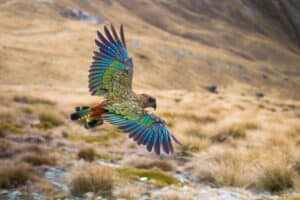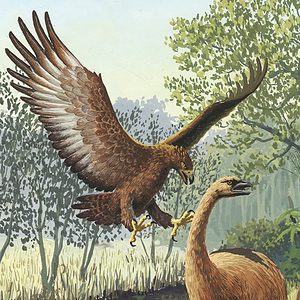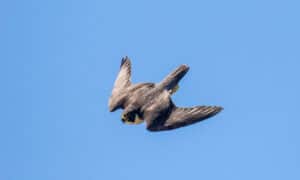Hawaii is a tropical paradise with some pretty unique creatures, especially when compared to other US States. They have several native bird species and many were introduced from parts of Asia to control pests. Today the island’s bird populations are flourishing among sandy beaches, lush jungles, mountains, and valleys. Discover 15 types of birds in Hawaii and learn about their habitats, diet, nests, and appearance.
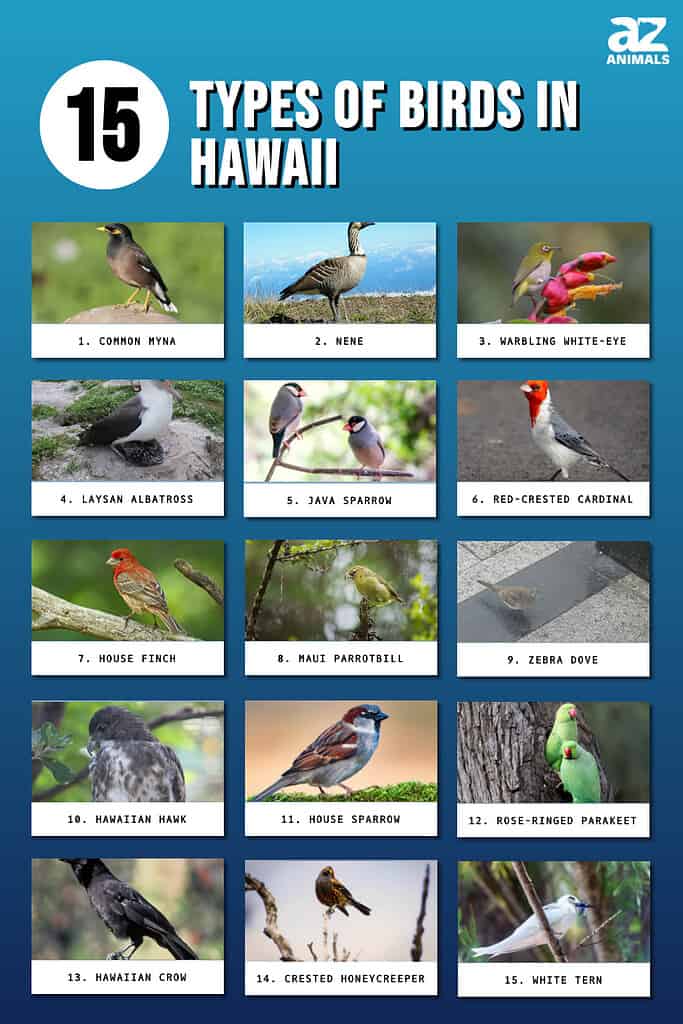
1. Common Myna
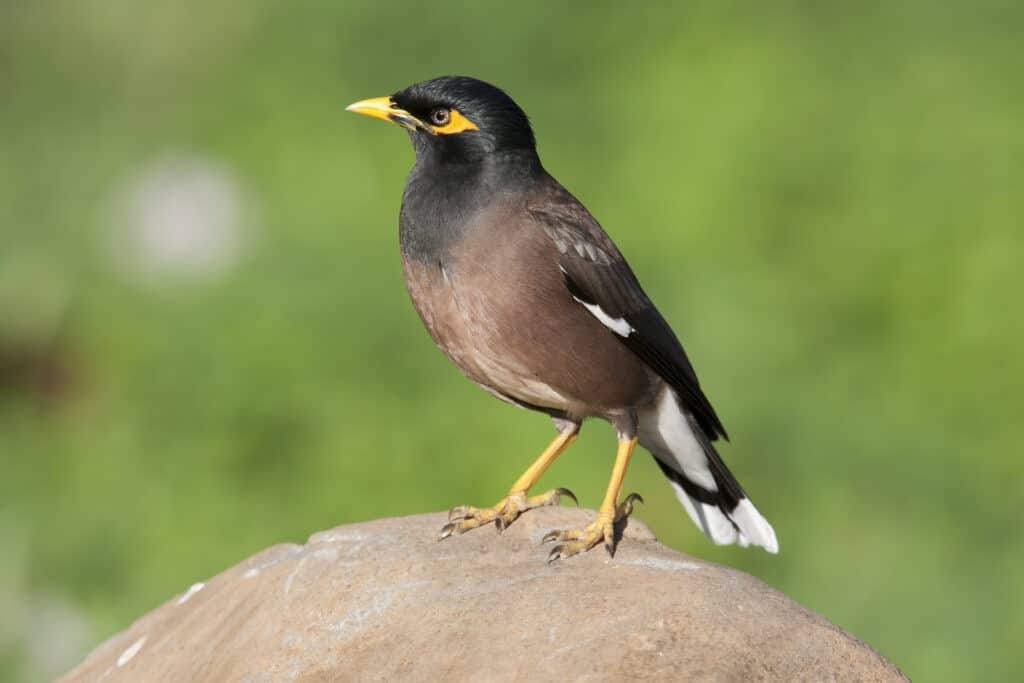
Common mynas are native to Asia and were introduced to Hawaii in 1865 to control
armyworm
populations.
©Stubblefield Photography/Shutterstock.com
Habitat and Range: The common myna is native to Asia and was introduced to Hawaii in 1865 to control armyworm populations. Today they are locally common birds in Hawaii and widespread. They live in open woodlands and around human habitations and may even be considered a nuisance to city buildings.
Features and Coloring: They have brown bodies and black heads with yellow patches behind the eyes.
Diet: Insects, crustaceans, reptiles, mammals, seeds, grains, and fruit
Vocalizations: Croaks, squawks, and chirps
Nests: Loose stick structures placed in manmade cavities
2. Nene

Hawaiian geese are endemic to Hawaii, where they live in grasslands and lava plains.
©Wunson/Shutterstock.com
Habitat and Range: The Nene, or Hawaiian goose, is endemic to the Hawaiian Islands. They are the official state bird. These geese inhabit grasslands, shrublands, lava plains, and coastal dunes.
Features and Coloring: They are medium-sized geese capable of flight. They have brown, buff, and black plumage.
Diet: These herbivores eat leaves, seeds, fruits, and flowers.
Vocalizations: Soft calls
Nests: Scrapes lined with down hidden under dense shrubs
3. Warbling White-Eye
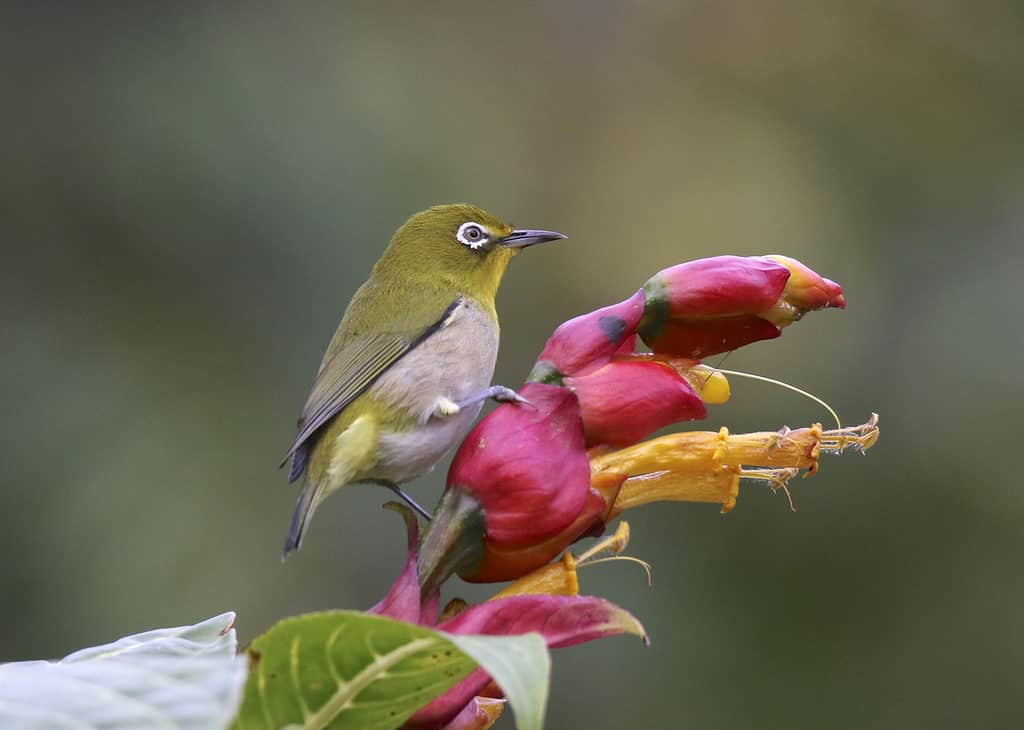
The warbling white-eye is common in Hawaii around forests and thickets.
©iStock.com/Nancy Strohm
Habitat and Range: The warbling white-eye has a native range in East Asia but is now common in Hawaii after being introduced to control pest species. They live in forests, open woodlands, and thickets.
Features and Coloring: These birds are pale green, olive, and yellow. And they feature a distinctive white eye ring (hence the name).
Diet: Fruit, insects, and nectar
Vocalizations: High-pitched twitters
Nests: Moss and lichen cups
4. Laysan Albatross
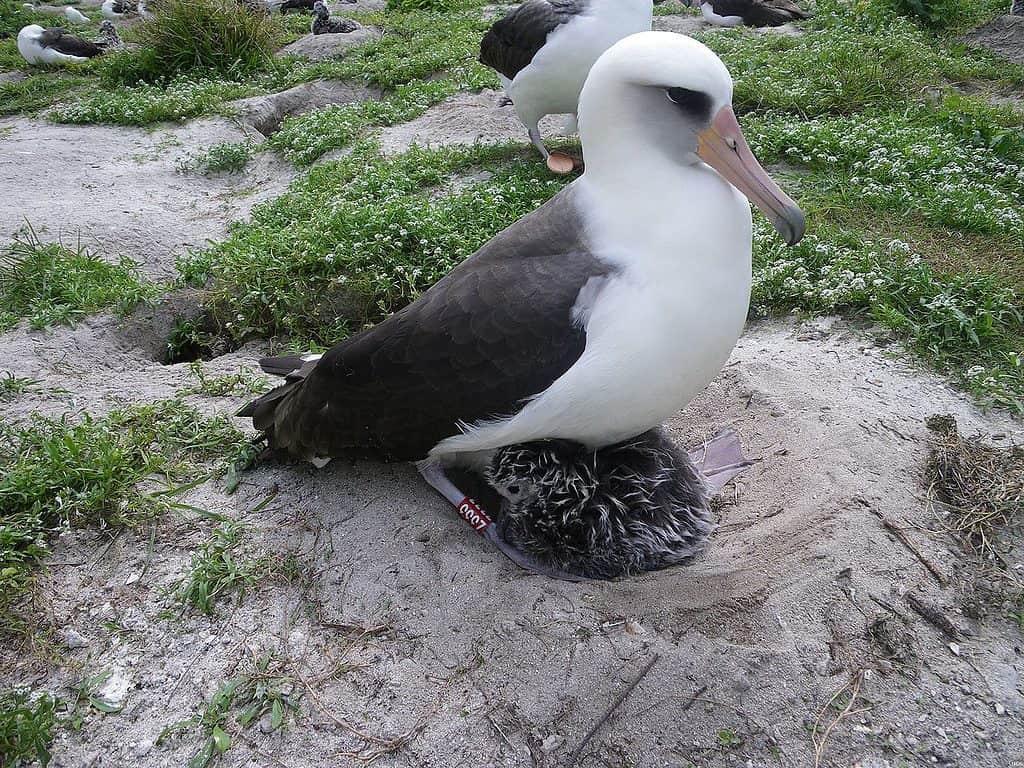
The Laysan
albatross
is native to the North Pacific, nesting on grassy islands and soaring over the ocean.
©John Klavitter/U. S. Fish and Wildlife Service / public domain – License
Habitat and Range: The Laysan albatross is native to the North Pacific, with the Hawaiian Islands accumulating almost one hundred percent of their range. They spend most of their time on the Pacific Ocean but will nest on open grassy islands.
Features and Coloring: These birds are 2 feet long with a 6-foot wingspan. They feature white heads and bodies, black tails and wings, and pink feet.
Diet: Cephalopods, fish, and crustaceans
Vocalizations: Whining, squeaking, and grunting
Nests: They make circular scrapes on sandy islands.
5. Java Sparrow

Java sparrows were introduced to Hawaii in the 1960s.
©iStock.com/Oscar Gutierrez Zozulia
Habitat and Range: Java sparrows are native to Indonesia and were introduced to Hawaii in the 1960s. Their preferred habitats include open woodlands, grasslands, and beach forests.
Features and Coloring: They have gray, pink, and white plumage, with red bills and eyering. They are rather large and full-bodied with thick beaks.
Diet: Grains and seeds
Vocalizations: Rapid “chip” calls
Nests: They nest in tree cavities or holes and eaves of buildings
6. Red-Crested Cardinal
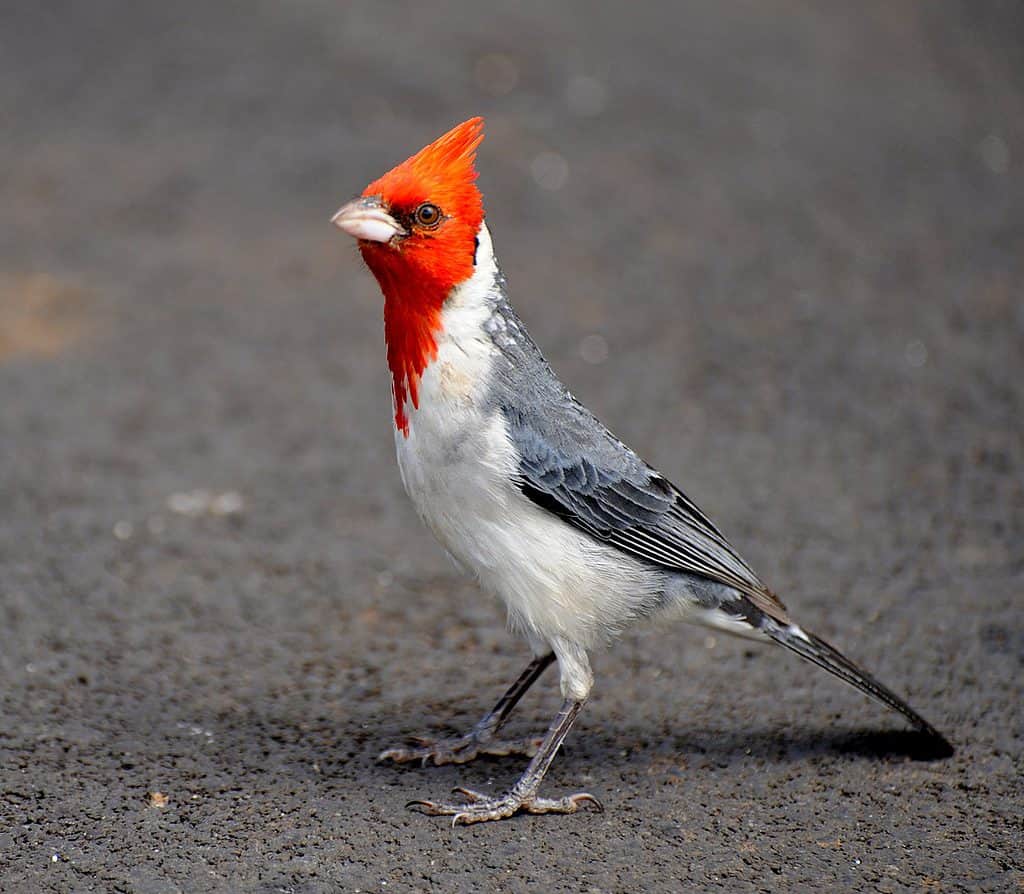
Red-crested cardinals live on the main Hawaiian Islands in dry shrubland and degraded forests.
©რობერტ (Robert), CC BY-SA 3.0 <https://creativecommons.org/licenses/by-sa/3.0>, via Wikimedia Commons – License
Habitat and Range: The red-crested cardinal is another introduced species to the main Hawaiian Islands. They are native to South America and inhabit dry shrubland and heavily degraded forests.
Features and Coloring: They have bright red heads, crests, and throats. And feature white bodies with gray backs, wings, and tails. They raise their crests when excited. This species is a popular red-headed bird in Hawaii.
Diet: Seeds, insects, and small arthropods
Vocalizations: Sweet, melodious notes
Nests: Open a cup in the fork of a tree
7. House Finch
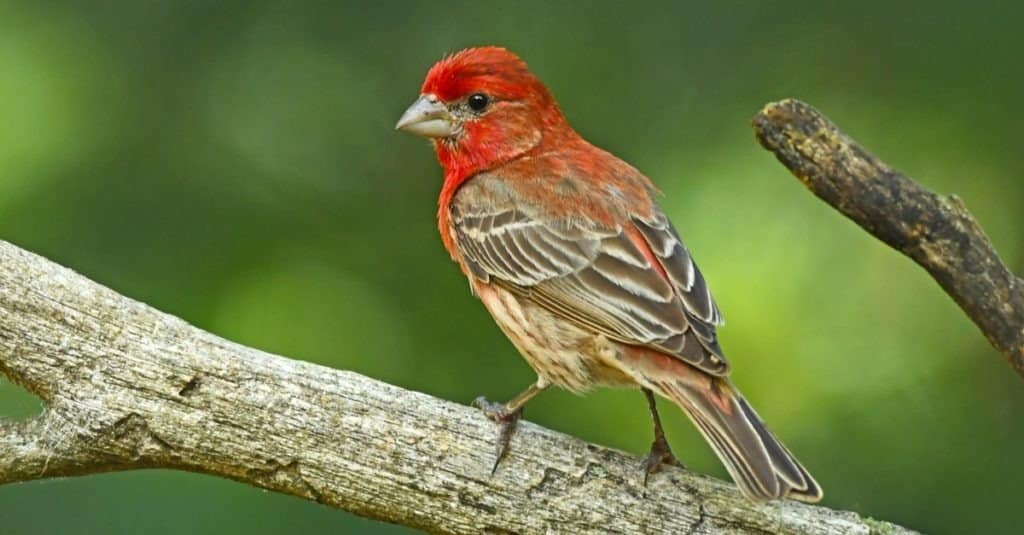
The
house finch
has rosy red and streaky brown plumage.
©Brian A Wolf/Shutterstock.com
Habitat and Range: House finches are native to Western North America but have been introduced to the Eastern US and Hawaii. They live on the dry sides of the islands in grasslands and open forests.
Features and Coloring: These small finches have short, thick bills and notched tails. Their plumage is rosy red and streaky brown.
Diet: Seeds, buds, and fruits
Vocalizations: Long, jumbled warbles
Nests: Leaf and stem cup placed in a tree
8. Maui Parrotbill
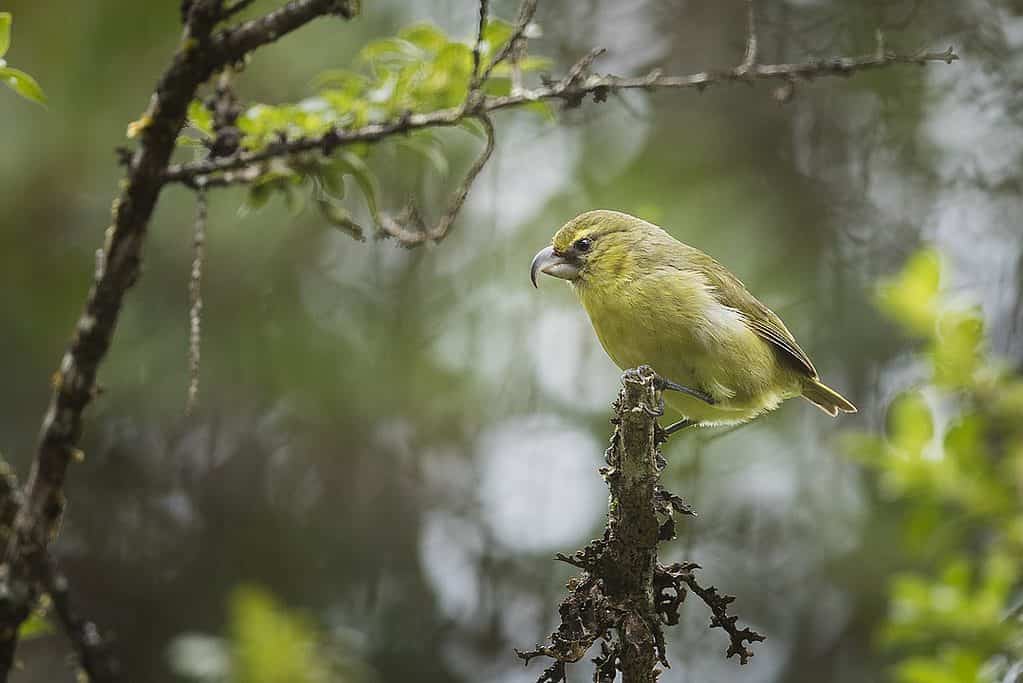
Maui parrotbills are endemic to tropical rainforests on the East Maui volcano.
©Zach Pezzillo, Maui Forest Bird Recovery Project, CC BY-SA 4.0 – License
Habitat and Range: The Maui parrotbill is endemic to the island of Maui in Hawaii. They live in the tropical rainforests on the windward slopes of the East Maui Volcano. Their range is approximately 19 square miles.
Features and Coloring: They are a large species of Hawaiian honeycreeper featuring yellow, olive-green, ivory, and dark gray plumage. They are one of the popular yellow birds in Hawaii.
Diet: Insects
Vocalizations: Short “chips”
Nests: A cup-shaped lichen nest 40 feet above the forest floor
9. Zebra Dove
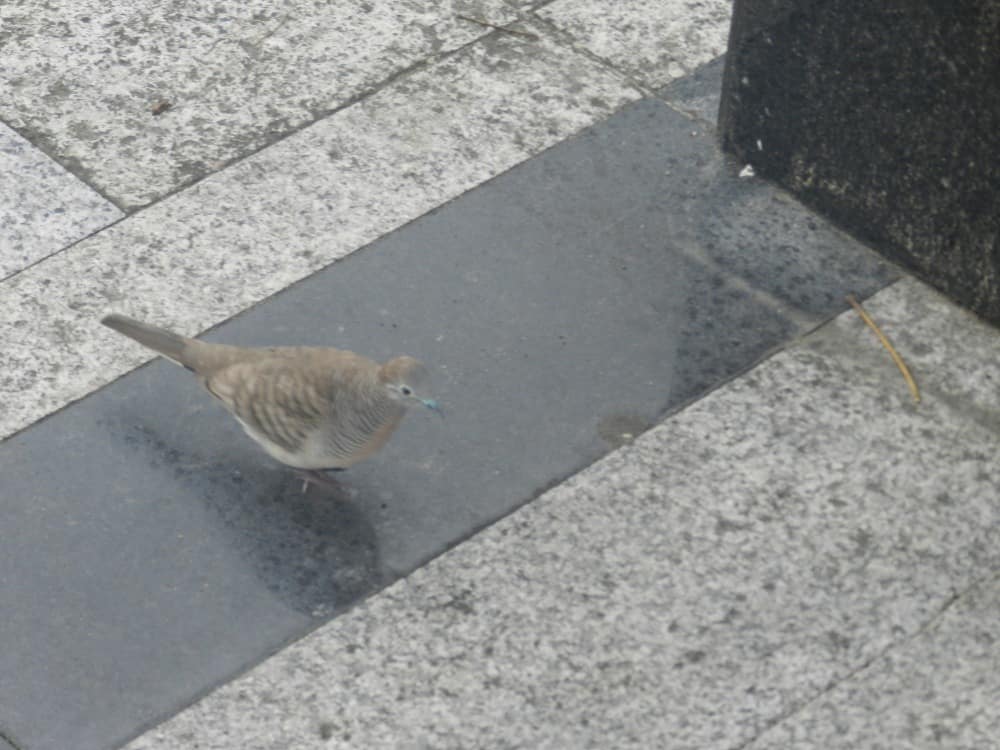
Zebra doves are one of the most abundant birds in Hawaii.
©Millie Bond – Copyright A-Z Animals
Habitat and Range: Zebra doves are native to Southeast Asia and were introduced to the Hawaiian Islands in the 1920s. They are now one of the most abundant species in the state. They live in scrub, farmland, and open country.
Features and Coloring: They are small and slender and feature long tails. They have brown and gray plumage with black and white barring.
Diet: Seeds, insects, and other small invertebrates
Vocalizations: Soft, staccato cooing
Nests: A platform made of leaves and grass and placed in bushes or trees
10. Hawaiian Hawk
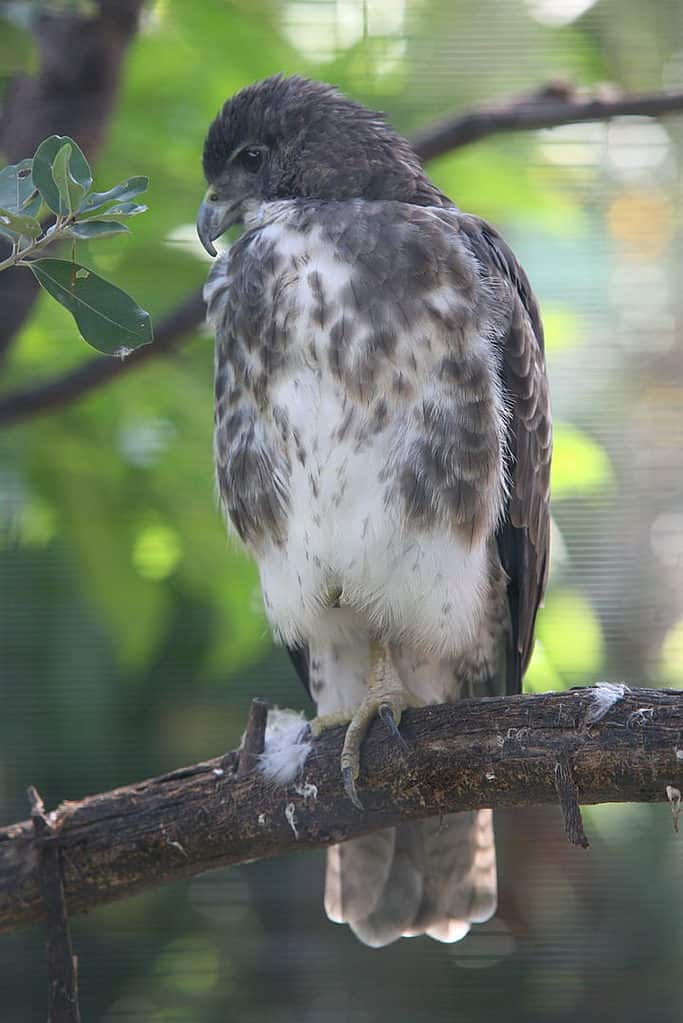
Hawaiian hawks are endemic to Hawaii and live in tropical forests and agricultural areas.
©cliff1066, CC BY 2.0 – License
Habitat and Range: The Hawaiian hawk is endemic to Hawaii and restricted to the Big Island during the breeding season. They have wide-ranging habitats, from tree plantations and tropical forests to agricultural areas.
Features and Coloring: These medium-sized birds of prey have two color morphs: dark brown and light brown.
Diet: Small mammals, birds, insects, and lizards
Vocalizations: Shrill, high-pitched calls
Nests: Bulky stick platforms in native trees
11. House Sparrow
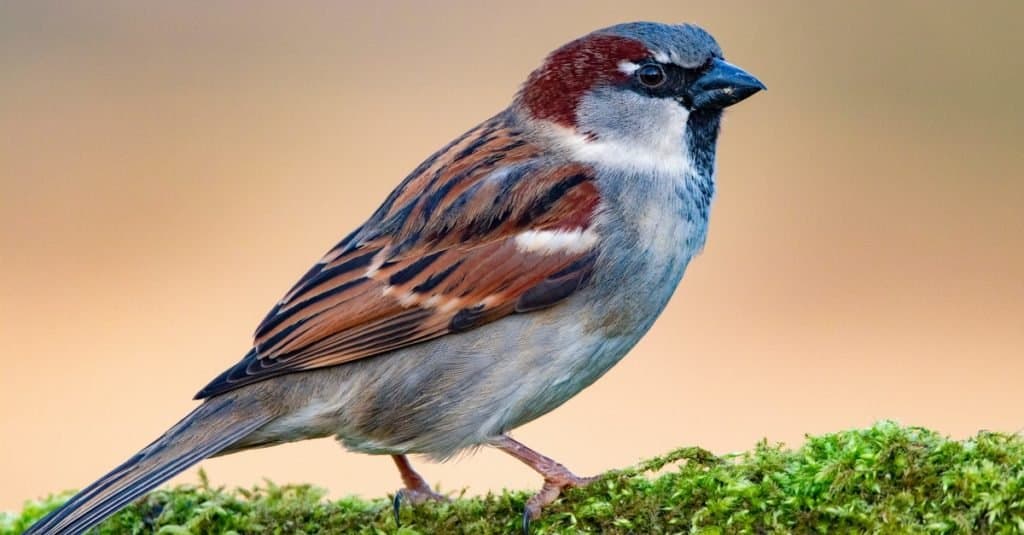
The house sparrow is common around human habitations in cities and towns.
©Craig Howman/Shutterstock.com
Habitat and Range: House sparrows are found in most parts of the world, including the Hawaiian Islands. They are common around human habitations in cities and towns, but you can also find them in woodlands, forests, and grasslands.
Features and Coloring: These birds are chunky with round heads and short, thick bills. Their plumage is gray, white, black, and chestnut.
Diet: Grains, seeds, and insects
Vocalizations: Simple “cheep” notes
Nests: They stuff holes in buildings (or other structures) with dried vegetation
12. Rose-Ringed Parakeet
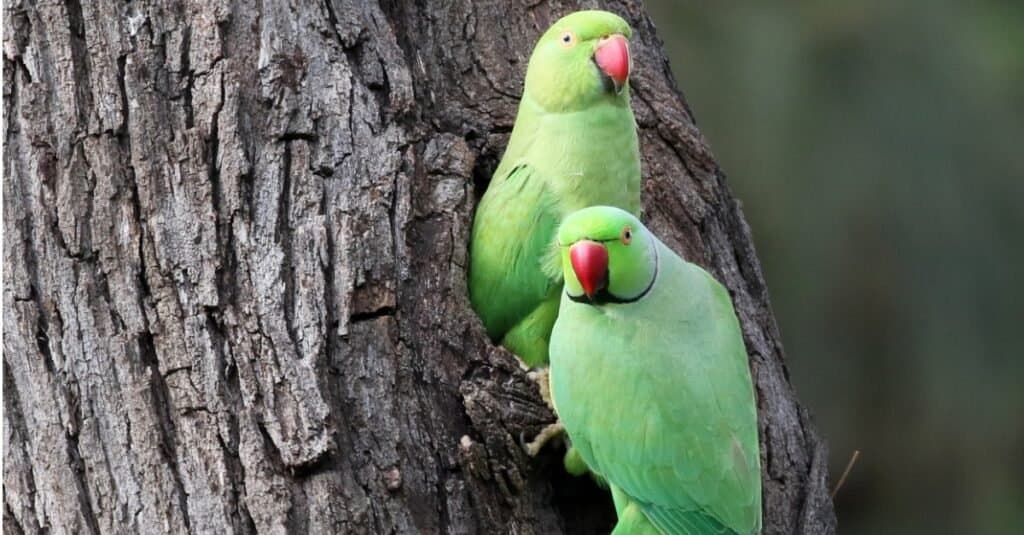
Rose-ringed parakeets are presumably good at recalling longer phrases. They live in grasslands and rainforests.
©Randy Bjorklund/Shutterstock.com
Habitat and Range: The rose-ringed parakeet has native ranges in Africa and India, but they exist in many other parts of the world, including Hawaii. They inhabit grasslands, shrublands, rainforests, and wetlands. You can also find them in cities and suburbs.
Features and Coloring: They are medium-sized parrots with bright green, yellow, and red plumage.
Diet: Fruits, vegetables, nuts, berries, and seeds
Vocalizations: Squawking calls
Nests: They line tree cavities with rotten wood
13. Hawaiian Crow
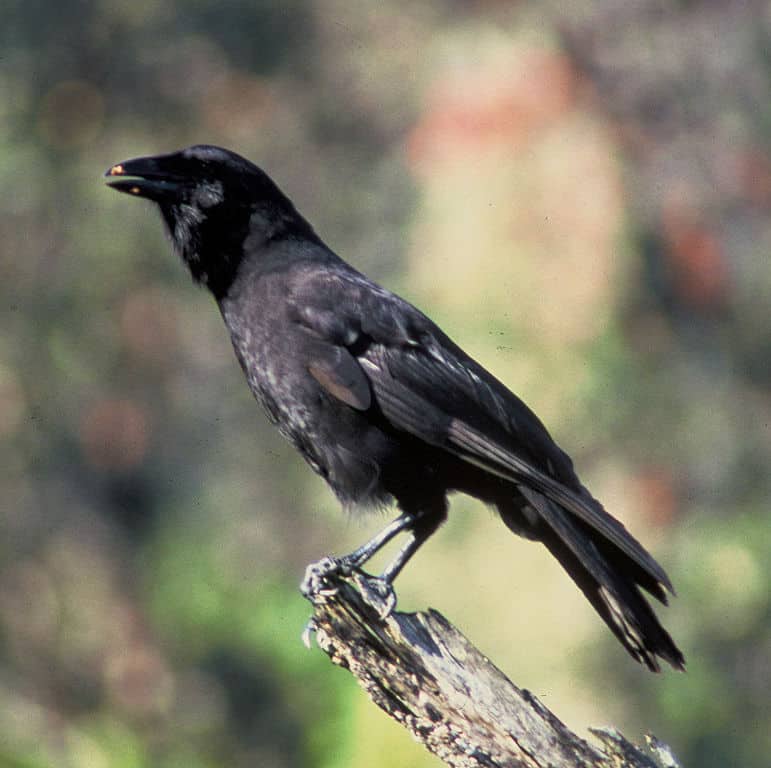
The Hawaiian crow is extinct in the wild but reintroduction programs are underway.
©U.S. Fish and Wildlife Service / public domain – License
Habitat and Range: The Hawaiian crow is endemic to Hawaii. However, it is currently extinct in the wild. Reintroduction programs are currently underway. They inhabited dry and mesic forests.
Features and Coloring: They are medium-sized crows with rounded wings and thick bills. They have brownish-black plumage and long-throat feathers.
Diet: Insects, spiders, birds, and flowers
Vocalizations: Two-toned screech
Nests: A twig and weed cup placed in a native tree
14. Crested Honeycreeper
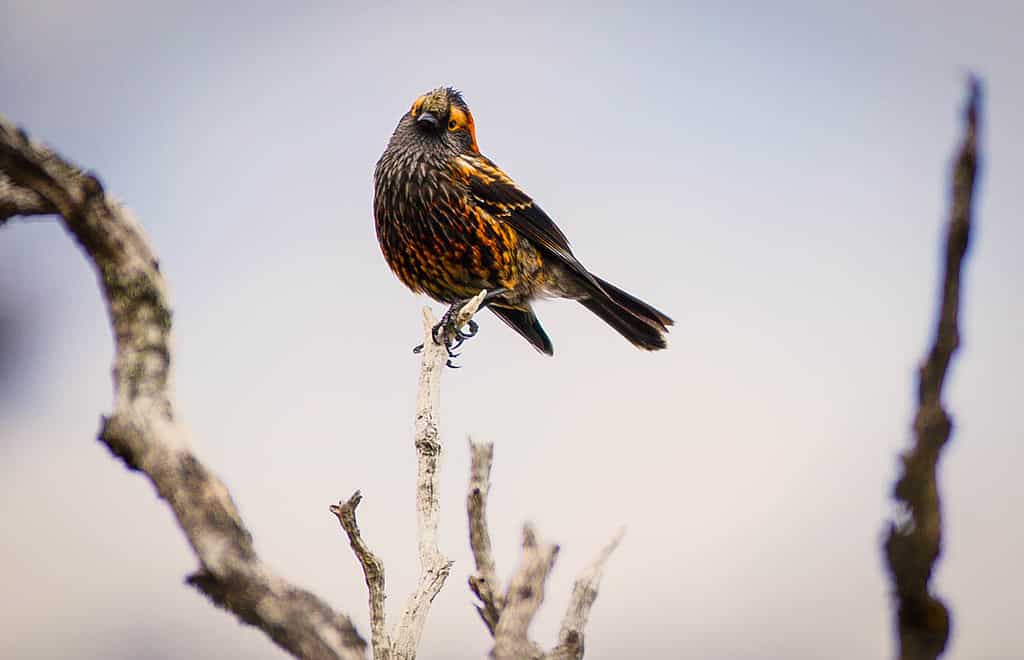
The Crested Honeycreeper can only be found on the island of Maui.
©NP Gallery/Public Domain – License
Habitat and Range: The crested honeycreeper is endemic to the island of Maui in Hawaii. They inhabit wet forests on the East Maui Volcano.
Features and Coloring: They are the largest honeycreeper on the island. They feature glossy black plumage with white stripes and orange and red patches.
Diet: Nectar, fruit, and insects
Vocalizations: Low chuckles and repeated calls
Nests: They place their nest cups in native trees.
15. White Tern
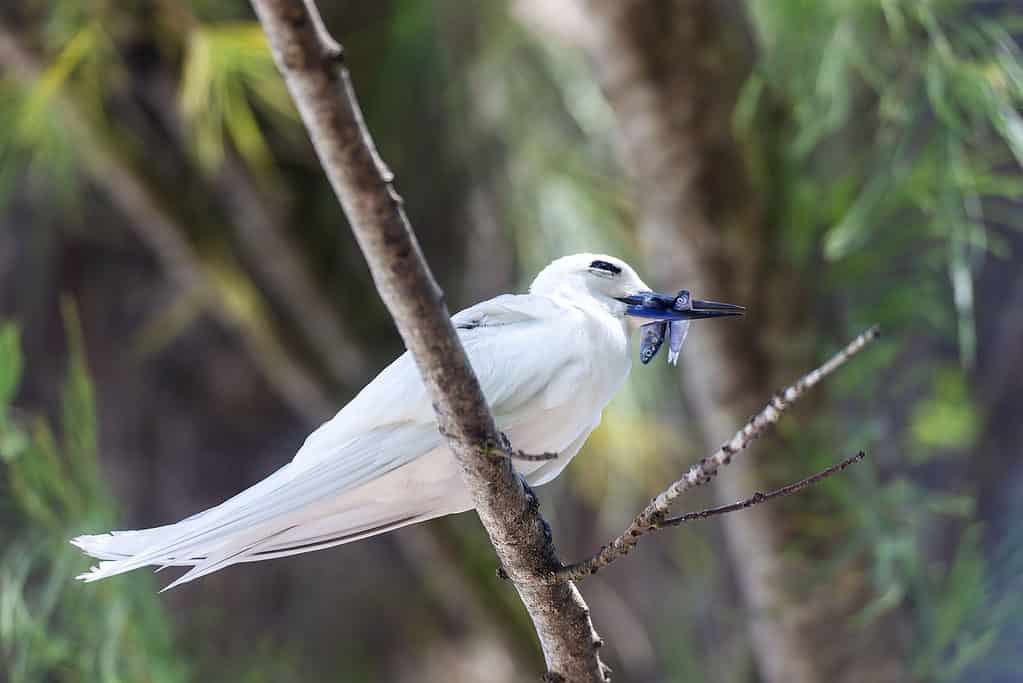
White terns are found across the world’s tropical oceans. They eat small fish.
©iStock.com/MarcStephan
Habitat and Range: As one of the white birds in Hawaii, the white tern is found across the world’s tropical oceans. They live along the Hawaiian coast and move into woodlands during the breeding season.
Features and Coloring: They are elegant-looking seabirds with long tails and long bills. Their plumage is snow-white with black spots around their eyes and black beaks.
Diet: Small fish
Vocalizations: Harsh, shrill calls
Nests: They nest on coral islands, rocky ledges, or buildings.
Summary of 15 Types Of Birds In Hawaii
| # | Bird | Appearance |
|---|---|---|
| 1 | Common Myna | Brown bodies with black heads and yellow patches behind the eyes |
| 2 | Nene | Medium-sized geese with brown, buff, and black plumage |
| 3 | Warbling White-Eye | Pale green, olive, and yellow with a distinctive white eye ring |
| 4 | Laysan Albatross | Large birds with white heads and bodies, black tails and wings, and pink feet |
| 5 | Java Sparrow | Gray, pink, and white plumage, with red bills and eye ring |
| 6 | Red-Crested Cardinal | Bright red heads, crests, and throats |
| 7 | House Finch | Small birds with short, thick bills and notched tails, rosy red plumage with brown streaks |
| 8 | Maui Parrotbill | Large birds with yellow, olive-green, ivory, and dark gray plumage |
| 9 | Zebra Dove | Small, slender birds with long tails and brown and gray plumage |
| 10 | Hawaiian Hawk | Medium-sized bird of prey with light brown or dark brown plumage |
| 11 | House Sparrow | Chunky little birds with round heads and short, thick bills – plumage is gray, white, black, and chestnut |
| 12 | Rose-Ringed Parakeet | Medium-sized parrots with bright green, yellow, and red plumage |
| 13 | Hawaiian Crow | Medium-sized crows with brownish-black plumage and long throat feathers |
| 14 | Crested Honeycreeper | Large birds with glossy black plumage with white stripes and orange and red patches |
| 15 | White Tern | Snow-white seabirds with black spots around their eyes and black beaks |
The photo featured at the top of this post is © iStock.com/alxpin
Thank you for reading! Have some feedback for us? Contact the AZ Animals editorial team.




